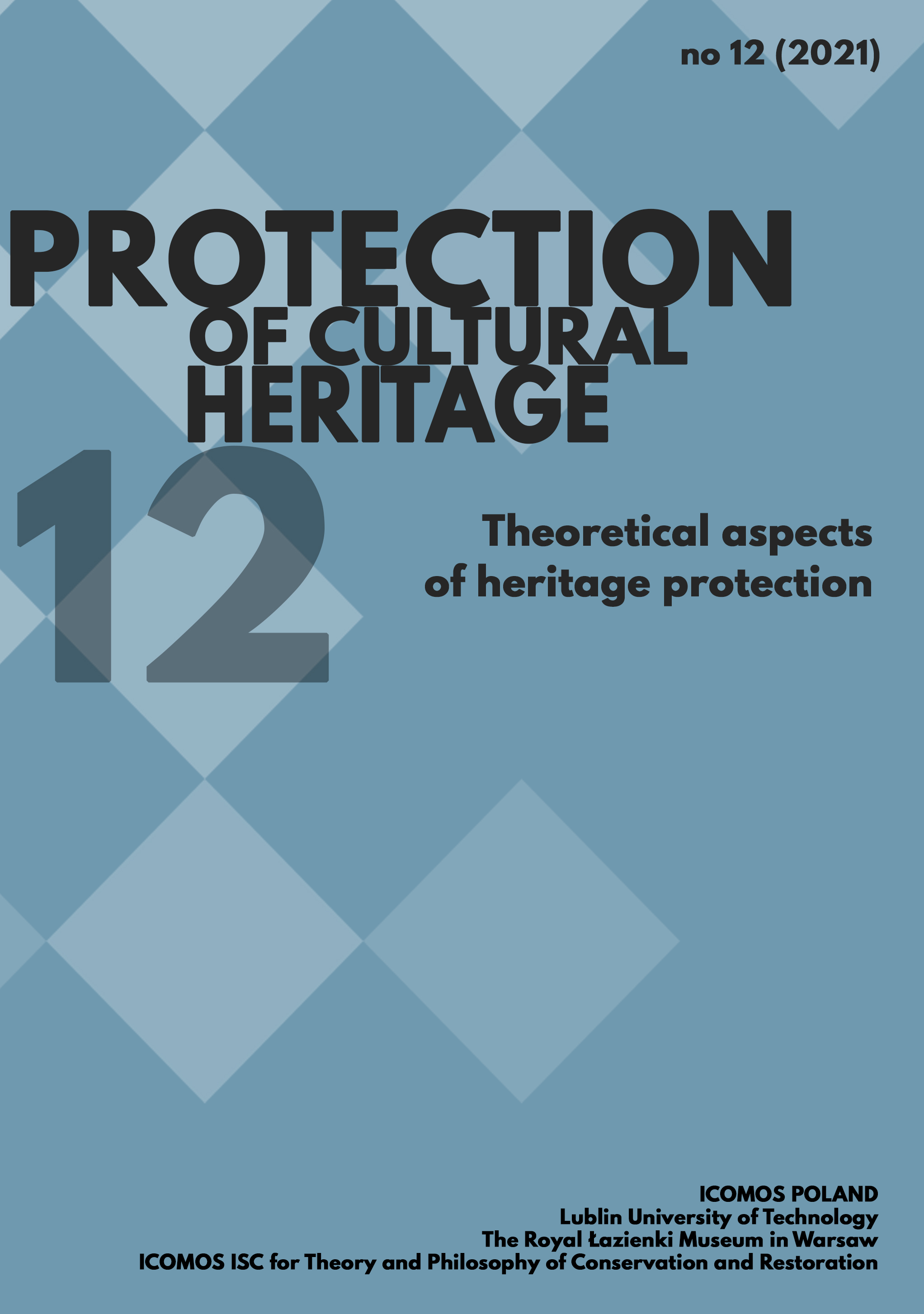Urban Conservation in International Charters From the Athens Charter to the Historic Urban Landscape Recommendation
Article Sidebar
Open full text
Issue No. 12 (2021)
-
Pierre Nora’s "Sites of Memory" and the Social Aspect of Issues in Built Heritage Conservation
Janusz Krawczyk, Małgorzata Balcer1-12
-
Learning from the Abode of Chaos : Institutions, Stakeholders and Contemporary Challenges of Conservation Doctrine
Claudine Houbart13-24
-
Archeological Monuments Protection System. Between Theory and Conservation Practice
Agnieszka Krawczewska25-34
-
Conservation Doctrines and the Pan-European Idea of the New European Bauhaus and the European Green Deal
Marcin Włodarczyk, Małgorzata Włodarczyk35-54
-
Alert in the 21st Century. Changes in Theory of Heritage Protection in Tangible, Intangible and Digital Signs
Iwona Szmelter55-70
-
Urban Conservation in International Charters
From the Athens Charter to the Historic Urban Landscape RecommendationRuxandra-Iulia Stoica71-78 -
The Climate Change Related Adaptation and Resilience of Traditional Tradicional Dwellings: the Case of Yucatan Penisula
Joel Audefroy, Bertha Nelly Cabrera Sanchez79-96
-
Conservation Practice and the Future of Doctrinal Texts
Nigel Walter97-112
-
The Congress of Athens of 1931: Methodological and Technical Contributions for the Conservation of Architectural and Environmental Heritage
Rosa Anna Genovese113-121
-
Reflections on Integral and Integrated Heritage Care at the Threshold of the Third Millennium
Marc Laenen123-138
-
World Heritage for Building Peace
Paolo Del Bianco141-147
Main Article Content
DOI
Authors
Abstract
This paper will present an analytical review of doctrinal texts that have been key for the shaping of integrated urban conservation practice internationally: from the Athens Charter to the Historic Urban Landscape Convention.
The 1931 Athens Charter for the Restoration of Historic Monuments was published at the same time when the Congres Internationaux d’Architecture Moderne was summing up its controversial urbanist ideology in its own Charte d'Athènes of 1933. Whilst the Athens Charter focused on technical aspects of monument restoration, the preceding debate showed a raising interest in historic urban areas. CIAM’s Charter too, despite including a section regarding historic urban areas, limited its recommendations to the protection of individual monuments or ensembles.
Substantial research of historic centres in European countries preceded the first national legislations and international charters targeted specifically at urban areas in 1960s and 70s. Notably, the 1964 Venice International Charter for the Conservation and Restoration of Monuments and Sites finally extended the concepts of restoration and rehabilitation of monuments to protected areas such as historical city centres, recommending expanded heritage protection legislation worldwide. European national legislations followed suit. In 1975, the European Architectural Heritage Year had seen also the first charter promoting the conservation of the historic built environment as a whole.
However, by the end of the 20th century, despite a good number of further doctrinal texts being adopted internationally, and the publication of numerous books, articles and reports touching on the problematic of urban conservation, the paucity of theoretical and conceptual advance of this field remained evident. The delay in giving a sound theoretical structure to the field of urban conservation has been, quite understandably, due to the complexity of the urban environment and the ensuing difficulty of separating out the effects of different variables at work within it.
Charters over the past three decades call for an integration of planning and urban conservation based on an appraisal of the historic urban fabric and its community, an approach which should eventually provide a more sustainable urban development. This means understanding and evaluating the significance of place, on one hand, and drawing out management implications for protecting this significance and identifying opportunities for change, on the other. The 2011 Historic Urban Landscape Recommendation goes some way to internationalise the theory and practice that has been developed so far predominantly within the European context.
There are many issues that have been raised through charters over the last hundred years, and many still need a proper theoretical framework that can allow them to be used in practice widely, beyond the places with strong heritage conservation traditions and legislations.
Keywords:
References
Choay F., L’Allégorie du patrimoine (Paris: Editions du Seuil, 1992), 126.
Jokilehto J., A History of Architectural Conservation (Oxford, Auckland, Boston, Johannesburg, Melbourne, New Delhi: Butterworth-Heinemann, 1999), 285.
Siewert P., “The Ephebic Oath in Fifth-Century Athens Source,” The Journal of Hellenic Studies, Vol. 97 (1977): 102-111, http://www.jstor.org/stable/631025 (Accessed: 10/07/2010). DOI: https://doi.org/10.2307/631025
Sitte C., Der Städtebau nach seinen künstlerischen Grundsätzen (Vienna, 1889).
Carta di Gubbio: Dichiarazione finale approvata all’unanimità a conclusione del Convegno Nazionale per la Salvaguardia e il Risanamento dei Centri Storici, 1960.UNESCO Recommendation Concerning the Safeguarding of the Beauty and Character of Landscapes and Sites, 1962.
CE Amsterdam Declaration of the Congress on the European Architectural Heritage, 1975
Conservation and rehabilitation of the historical and cultural heritage, Habitat Agenda, http://www.unhabitat.org (accessed 30 December 2008), 67-8.
ICOMOS Washington Charter on the Conservation of Historic Towns and Urban Areas, 1987.
UNESCO Nairobi Recommendation concerning the Safeguarding and Contemporary Role of Historic Areas, 1976.
Venice International Charter for the Conservation and Restoration of Monuments and Sites, 1964.
Article Details
Abstract views: 628
License

This work is licensed under a Creative Commons Attribution-ShareAlike 4.0 International License.






